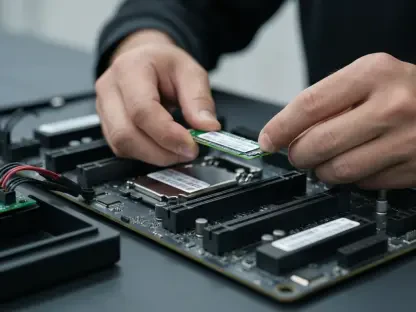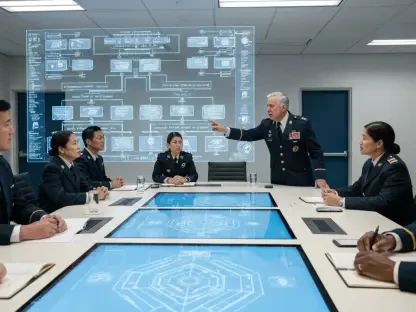In a world where aerial combat grows increasingly complex and resource constraints tighten military budgets, the U.S. Air Force has turned to a groundbreaking solution to redefine pilot training for the F-16 Fighting Falcon. Red 6, a Florida-based innovator founded in 2018 by former fighter pilots, has secured a pivotal contract with the Air Force Research Laboratory and Air Combat Command to integrate its Airborne Tactical Augmented Reality System (ATARS) into the cockpit of this iconic frontline fighter jet. This development marks a historic leap from conventional training methods, ushering in an era of immersive, cost-effective simulations that replicate intense air combat scenarios during live flight. Unlike traditional approaches that rely on expensive aggressor squadrons or contracted adversaries, ATARS projects virtual threats directly into the pilot’s view, blending the physical rigors of flight with dynamic digital challenges. This technology not only promises to enhance readiness but also addresses long-standing logistical and financial hurdles in military aviation training.
Transforming Combat Preparation with AR
The integration of ATARS into F-16 training represents a seismic shift in how pilots prepare for the demands of modern warfare. By utilizing a specialized wide field-of-view augmented reality headset seamlessly paired with standard flight helmets, this system overlays virtual adversaries, missiles, and tactical elements directly into the pilot’s line of sight. Unlike static ground-based simulators that fail to replicate the visceral stresses of flight, ATARS ensures that trainees experience real G-forces, atmospheric conditions, and cockpit workload while engaging in simulated dogfights. This unique fusion of live flight and synthetic combat creates an unparalleled training environment that mirrors the chaos of actual missions. The result is a more authentic preparation for the split-second decisions and high-stakes scenarios pilots face in battle, setting a new standard for realism in military aviation education.
Beyond realism, ATARS offers a scalable solution that amplifies the scope of training exercises through Red 6’s proprietary Collaborative Airborne Training Environment, known as CARBON. This innovative framework enables multiple aircraft to operate within a shared virtual battlespace, often described as an “outdoor military metaverse.” Such connectivity allows for intricate, large-scale mission simulations that were once reserved for rare, resource-intensive exercises. Now, routine unit drills or formal training programs can incorporate complex scenarios involving numerous virtual threats and allies, preparing pilots for the unpredictable nature of evolving aerial conflicts. This adaptability not only enhances skill development but also significantly reduces the costs associated with staging massive training operations, making high-quality combat preparation more accessible and frequent for aircrews across various squadrons.
A Historic Leap for Frontline Fighter Training
The deployment of ATARS in the F-16 Fighting Falcon stands as a landmark achievement, transitioning the technology from its earlier applications in trainer aircraft like the T-38 Talon to a premier tactical fighter. This milestone underscores the confidence placed in Red 6’s vision, as articulated by CEO Daniel Robinson, who emphasizes the system’s unmatched ability to replicate the cognitive intricacies of real-world engagements. Moving to a frontline platform like the F-16 signals a broader potential for ATARS to influence training protocols across diverse military aircraft in the coming years. It’s a clear indicator that augmented reality can meet the rigorous demands of operational combat units, paving the way for a future where virtual training becomes a cornerstone of military aviation strategy.
This advancement also highlights the strategic importance of staying ahead in a rapidly changing battlespace where threats evolve at an unprecedented pace. By integrating ATARS into the F-16, the U.S. Air Force ensures that pilots are not only familiar with cutting-edge technology but are also conditioned to handle the mental and tactical challenges of modern air combat. The system’s ability to simulate diverse enemy tactics and scenarios during live flight offers a dynamic training tool that static simulators or limited live exercises cannot match. This step forward validates years of development and testing, positioning Red 6 as a leader in redefining how frontline fighters prepare for missions, with implications that could extend to international air forces seeking similar innovations to bolster their readiness.
Addressing Long-Standing Training Obstacles
One of the most pressing challenges in military pilot training has been the exorbitant cost and logistical complexity of traditional adversary programs, often involving dedicated Red Air aggressor squadrons or contracted services. These methods, while effective in mimicking enemy tactics, strain budgets due to high operational expenses, limited aircraft availability, and the wear on aging airframes. ATARS directly confronts these barriers by introducing intelligent virtual threats into the pilot’s field of view, eliminating the need for additional physical aircraft during training. This approach allows for an exponential increase in the number and sophistication of combat scenarios without the associated resource drain, offering a sustainable alternative that maintains the high standards required for combat readiness.
Furthermore, the flexibility of ATARS alleviates the pressure on existing training infrastructures, which often struggle to meet the demand for frequent and varied exercises. By enabling virtual adversaries that can adapt in real-time to pilot actions, the system ensures that each session remains challenging and relevant to current threats. This capability reduces dependency on external services and dedicated units, allowing the Air Force to allocate resources more efficiently while still delivering top-tier training. The technology complements rather than replaces traditional methods, suggesting a hybrid model where live and virtual elements coexist to maximize effectiveness. As a result, squadrons can maintain operational tempo without sacrificing the depth or quality of preparation needed for success in complex aerial engagements.
Pioneering a Tech-Driven Future in Aviation
The adoption of ATARS in F-16 training reflects a broader movement within the U.S. Air Force to embrace advanced technologies like augmented reality for enhancing military readiness while curbing expenses. Significant investments, including substantial contracts starting from recent years, alongside collaborations with major industry players such as Lockheed Martin and Boeing, underscore the strategic priority placed on simulation-driven solutions. ATARS bridges a critical gap left by conventional simulators by combining the tangible sensations of flight with ever-changing virtual threats, ensuring pilots are conditioned for both the physical and psychological rigors of combat. This trend toward technology integration signals a transformative era in military aviation, where readiness is no longer constrained by resource limitations.
Looking at the wider implications, the success of ATARS in the F-16 program points to a future where augmented reality could become a standard across global air forces. International interest, evidenced by demonstration flights with allied militaries, suggests a growing recognition of AR’s potential to revolutionize training methodologies. The emphasis on physiological and cognitive realism provided by this system addresses deficiencies in older training paradigms, preparing pilots for the multifaceted challenges of modern warfare. As partnerships expand and further platforms adopt this technology, the Air Force’s investment in ATARS positions it at the forefront of a paradigm shift, ensuring that aerial combat training evolves in step with the complexities of today’s geopolitical landscape.
Reflecting on a New Era of Pilot Readiness
Looking back, the integration of Red 6’s ATARS into the F-16 cockpit marked a defining moment in military training history, skillfully blending the authenticity of live flight with the adaptability of virtual simulations to equip pilots for contemporary aerial challenges. It tackled persistent issues of cost and resource scarcity head-on, while aligning seamlessly with the push toward technology-driven solutions in defense. As this system gained traction across platforms and drew international attention, it reshaped the landscape of air combat preparation. Moving forward, the focus should be on expanding compatibility with diverse aircraft and refining the technology to address emerging threats. Continuous collaboration with industry partners and allied forces will be crucial to sustain momentum, ensuring that training remains agile and effective in an ever-shifting battlespace. This journey reflects a commitment to innovation, promising a future where pilots are better prepared than ever before.









